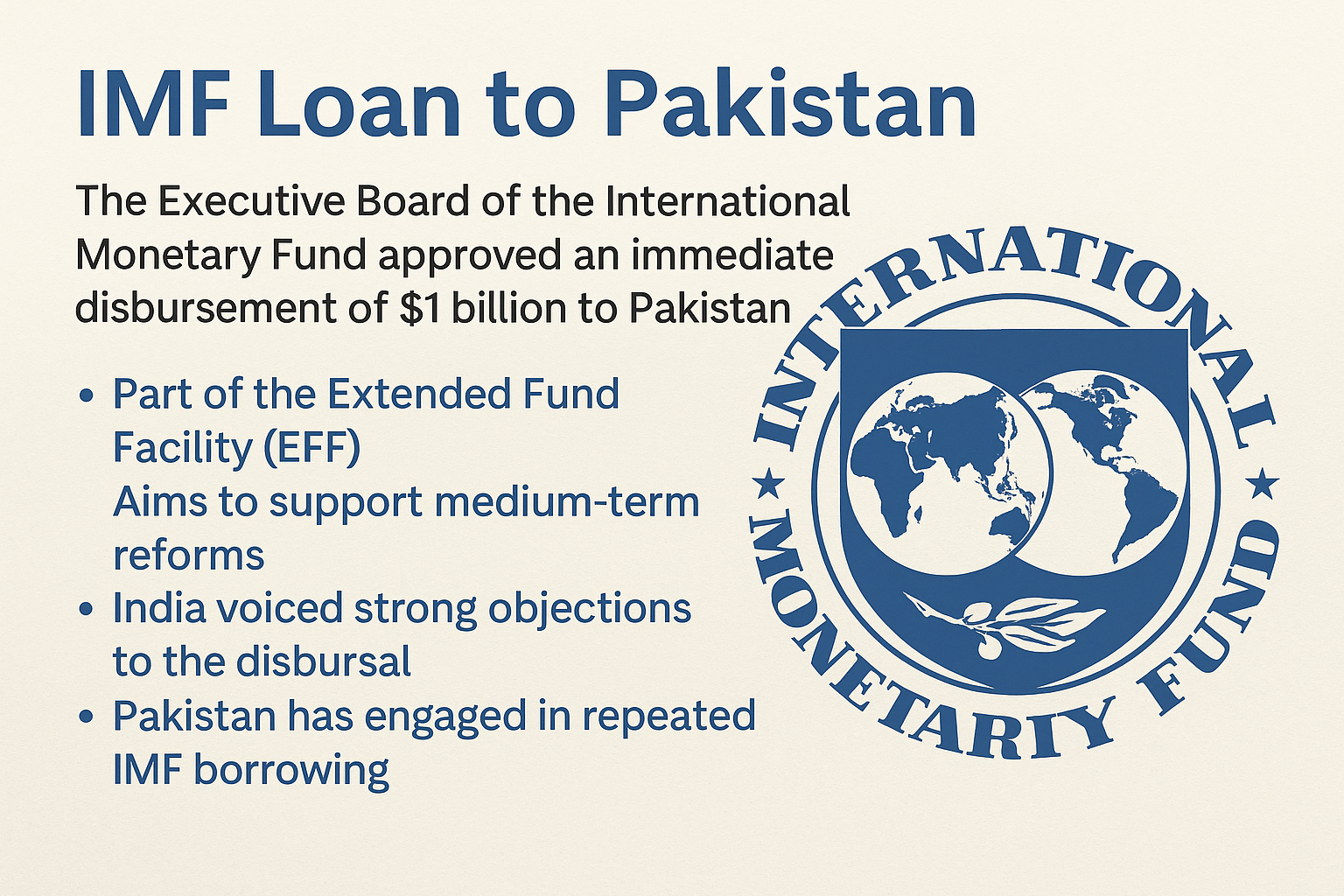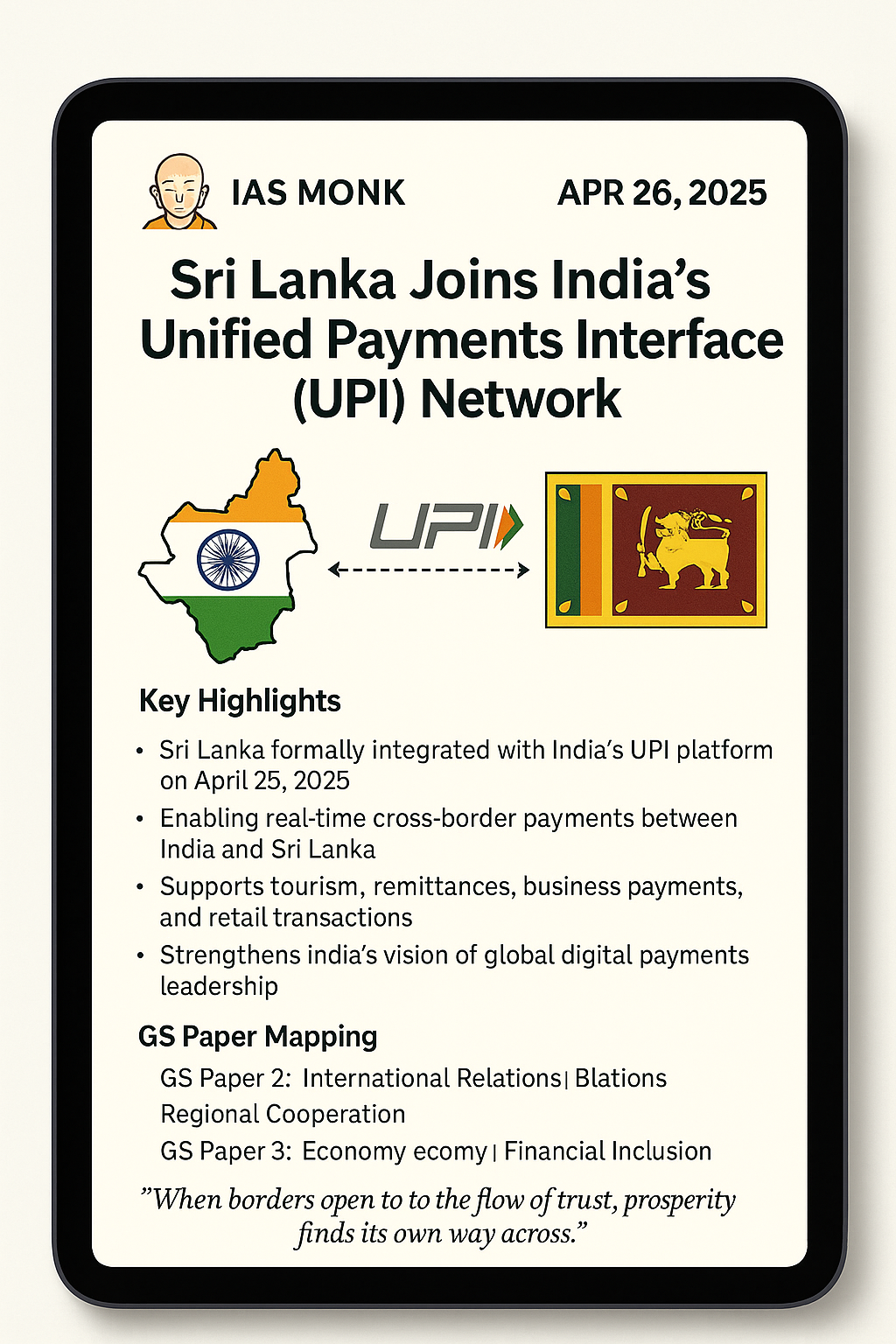
📅 May 12, 2025, Post 4: 🧾 IMF Loan to Pakistan: Aid, Reform or Risk? |High Quality Mains Essay | Prelims MCQs
🧾 IMF Loan to Pakistan: Aid, Reform or Risk?

INTERNATIONAL HERO — PETAL 004
🗓️ May 12, 2025
📚 GS Paper 2 – International Relations / Institutions
🌍 Intro Whisper
When a nation borrows hope in billions,
Will it invest in peace — or prepare for war?
🔹 Key Highlights
- $1 Billion IMF Loan: Approved under the Extended Fund Facility (EFF), this is part of Pakistan’s long-standing engagement with IMF, marking its 28th loan in 35 years.
- EFF Mechanism: Unlike short-term bailouts, the EFF supports medium-term reforms — covering structural inefficiencies like fiscal mismanagement, low savings, and inadequate infrastructure.
- India’s Dissent: India objected citing concerns over misuse of funds and national security, highlighting Pakistan’s track record of economic mismanagement and state-sponsored terrorism.
- IMF Justification: Despite risks, the IMF noted recent improvements — such as inflation dropping to 0.3% in April 2025, improved foreign reserves, and fiscal reforms.
- RSF Linkage: Pakistan may also tap into the Resilience and Sustainability Facility (RSF), intended for macro-reforms against climate and pandemic shocks.
📘 Concept Explainer: How IMF EFF & RSF Work
🏛️ Extended Fund Facility (EFF)
- Designed for medium-term structural reforms, not short-term bailouts.
- Offers longer repayment timelines.
- Aims at tackling chronic economic weaknesses — e.g., low investment, governance failures, tax reform.
- Loan conditionalities are reform-centric, with periodic reviews.
- Funds are not grants — they must be repaid with interest.
🌿 Resilience and Sustainability Facility (RSF)
- Focused on climate-related and pandemic preparedness reforms.
- Offers low-interest, long-duration financing.
- Strengthens economic buffers and macro-stability.
- Pakistan’s fragile climate and healthcare infrastructure make it a likely candidate.
📉 Why Pakistan Seeks IMF Support Again
- Stagnant Economy: GDP in 2023 fell below 2017 levels (US$ 338 billion).
- Inflation Crisis: Double-digit inflation for five years, peaking at 23.4% in 2024.
- Debt Dependency: IMF, China, UAE, Saudi Arabia, Paris Club, and Islamic Development Bank — Pakistan borrows from all.
- Weak Macro Indicators: Low female participation, energy shortfalls, low tax base, poor savings/investment ratio.
🇮🇳 India’s Stand: Reform or Risk?
- Track Record Concerns: India flagged repeated non-compliance with reform conditions in past IMF loans.
- Security Threat: IMF funding could indirectly support military or terror operations against India.
- Diplomatic Abstention: India abstained from the IMF vote, as member states cannot outright veto IMF decisions.
🗺️ GS Paper Mapping
| Paper | Theme | Relevance |
|---|---|---|
| GS-2 | International Institutions | IMF, Extended Fund Facility (EFF), RSF |
| GS-2 | International Relations | India–Pakistan relations, financial diplomacy |
| GS-3 | Economy | Balance of Payments, structural reforms |
✨ A Thought Spark — by IAS Monk
When reforms become rituals
And debt becomes tradition,
Aid turns into anesthesia —
Numbing both justice and judgment.
High Quality Mains Essay For Practice :
Word Limit 1000-1200
Debt, Diplomacy, and Dissent: India, Pakistan, and the IMF’s Strategic Balancing Act
🌐 Introduction: A Crisis Beyond Economics
In a world increasingly defined by economic interdependence and geopolitical rivalry, the role of international financial institutions like the International Monetary Fund (IMF) extends far beyond fiscal stabilization. The recent disbursement of $1 billion to Pakistan under the IMF’s Extended Fund Facility (EFF) has reignited questions about the intersection of aid, accountability, and international security — especially from India, a neighbor bearing the brunt of Pakistan’s decades-long cross-border hostilities. This essay explores the multidimensional implications of this disbursement: its economic rationale, Pakistan’s structural dependency, and India’s growing dissent in the geopolitical arena.
📉 Pakistan’s Economic Freefall: A History of Borrowed Survival
Pakistan has been trapped in a repetitive debt cycle, borrowing not to grow, but to survive. The numbers speak volumes:
- 28 IMF loans in 35 years — a staggering frequency.
- Double-digit inflation since 2019, peaking at 23.4% in 2024.
- Stagnant GDP, falling to $338 billion in 2023, below 2017 levels.
- A fiscal deficit consistently in the red, due to a narrow tax base and skewed subsidies.
- Growing dependence on external lenders like China, UAE, Saudi Arabia, and multilateral clubs.
Pakistan’s inability to generate domestic capital, attract consistent FDI, or implement deep-rooted reforms has forced it to rely on international bailouts, with the EFF becoming a lifeline rather than a reform tool.
🏛️ What is the Extended Fund Facility (EFF)?
The EFF is a structured IMF program designed for countries facing medium-term balance of payments problems, often due to structural deficiencies. It differs from emergency bailouts in three key ways:
- Longer repayment periods, allowing sustained recovery.
- Conditional lending, demanding deep reforms in taxation, public finance, and governance.
- Periodic performance reviews, linked to disbursements.
Unlike grants or humanitarian aid, EFF loans must be repaid with interest, making them both an economic and political commitment.
In theory, Pakistan fits the EFF profile — a country with long-standing structural issues. However, the disconnect between theory and practice remains stark in its case.
🌿 New-Age Facility: Resilience and Sustainability Fund (RSF)
Pakistan also becomes a probable candidate for the IMF’s Resilience and Sustainability Facility (RSF) — a new lending stream aimed at helping nations tackle climate vulnerability and pandemic preparedness. Though designed for noble ends, RSF disbursements in fragile economies like Pakistan raise fresh questions about transparency and absorption capacity.
🇮🇳 India’s Opposition: Security Over Statistics
India’s concerns, though voiced diplomatically through abstention, rest on two primary pillars:
1. Misuse of Funds
Pakistan has repeatedly violated IMF conditionalities, diverting funds for non-reformist objectives. India argues that:
- Structural reforms are often superficial or reversed.
- Military and security establishments consume disproportionate public expenditure.
- Subsidies and populism, not productivity, are funded through debt.
2. National Security Risk
India sees a direct link between economic bailout and state-sponsored terror:
- IMF loans free up domestic resources that could be funneled to military or terror operations.
- Despite international commitments, cross-border attacks, proxy warfare in Kashmir, and arms smuggling persist.
- As a victim of these attacks, India questions whether the global financial system is indirectly subsidizing insecurity in South Asia.
Though the IMF does not allow a formal vote against disbursement, India’s abstention was a powerful symbolic protest.
🧭 IMF’s Balancing Act: Reform vs Realpolitik
From the IMF’s lens, the loan reflects a strategic compromise:
- Stabilizing Pakistan prevents a full-blown economic collapse in a nuclear-armed state.
- Pakistan’s location — bordering Afghanistan, China, and Iran — gives it immense geostrategic leverage.
- Denying aid risks pushing Pakistan fully into China’s orbit.
The IMF thus walks a tightrope — preserving fiscal discipline while preventing geopolitical fragmentation. However, this pragmatism has long-term consequences:
- It undermines rule-based conditional lending.
- It disillusions democratic neighbors like India.
- It gives military-leaning regimes undue financial cushioning.
📚 The IMF’s Role in a Shifting World Order
As the global South becomes more vocal, and multipolarity gains momentum, India’s challenge also serves as a test of the IMF’s evolving legitimacy:
- Should security externalities be included in economic lending?
- Can non-reforming regimes be perpetually bailed out?
- Is there room for regional accountability in global lending?
India’s protest also signals a new era of financial diplomacy, where economics, ethics, and security converge.
💡 Reforming the Reformers: What Can Be Done?
To prevent further credibility erosion, both the IMF and recipient states like Pakistan must consider key reforms:
- Transparent Fund Tracking: Every disbursement must be tracked down to the last dollar.
- Military Budget Disclosure: Lending must factor military spending relative to social sector investments.
- Regional Impact Audits: Institutions like IMF must assess how lending affects neighbors.
- Performance-Linked Disbursement: Milestones should be strictly enforced.
- Alternative Channels for Vulnerable Groups: Climate or pandemic aid must bypass inefficient central mechanisms when needed.
🧠 Conclusion: Dollars and Dangers
In a region like South Asia, where borders are tense, institutions are fragile, and trust is scarce, even a financial loan becomes a strategic act. The IMF’s disbursal to Pakistan may stabilize its short-term balance sheet, but it risks unbalancing the regional security ledger.
India’s measured dissent marks a shift — from silent acceptance to strategic assertion in the global economic arena. If the IMF is to remain a pillar of stability, it must listen not just to governments seeking aid, but to neighbors seeking peace.
🧾 Closing Quote
“You cannot balance a nation’s budget by unbalancing a region’s peace.” — IAS Monk
Target IAS-26: Daily MCQs :
📌 Prelims Practice MCQs
Topic:
MCQ 1: Type – “How many of the above statements are correct?”
Consider the following statements regarding the Extended Fund Facility (EFF):
1.The EFF provides long-term grants to countries for humanitarian purposes.
2.It is a loan-based mechanism designed for structural economic reforms.
3.Loans under EFF must be repaid with interest.
4.Pakistan received EFF assistance due to balance of payments and structural issues.
How many of the above statements are correct?
A) Only two
B) Only three
C) All four
D) Only one
🌀 Didn’t get it? Click here (▸) for the Correct Answer & Explanation
✅ Correct Answer: B) Only three
🧠 Explanation:
•1) Incorrect – EFF provides loans, not grants.
•2) Correct – It is designed for medium-term reforms.
•3) Correct – Repayment with interest is mandatory.
•4) Correct – Pakistan qualified due to structural and fiscal instability.
MCQ 2: Type – Two Statements
Consider the following two statements:
1.India formally voted against the IMF’s $1 billion disbursal to Pakistan.
2.India expressed concern that the funds might indirectly support military or terror-related activities.
Which of the above statements is/are correct?
A) Only 1 is correct
B) Only 2 is correct
C) Both are correct
D) Neither is correct
🌀 Didn’t get it? Click here (▸) for the Correct Answer & Explanation
✅ Correct Answer: B) Only 2 is correct
🧠 Explanation:
•1) Incorrect – India abstained; IMF rules do not allow a direct “no” vote.
•2) Correct – India warned of potential misuse related to national security.
MCQ 3: Type – “Which of the above is/are correct?”
Consider the following statements about the IMF:
1.It was founded at the Bretton Woods Conference in 1944.
2.Its main role includes providing grants to member countries.
3.It has 190 member countries, with voting power based on quota contributions.
4.India is the largest contributor to the IMF.
Which of the above statements is/are correct?
A) 1 and 3 only
B) 2 and 4 only
C) 1, 2, and 3 only
D) All of the above
🌀 Didn’t get it? Click here (▸) for the Correct Answer & Explanation
✅ Correct Answer: A) 1 and 3 only
🧠 Explanation:
•1) Correct – IMF was established in 1944.
•2) Incorrect – IMF gives loans, not grants.
•3) Correct – Voting power is based on quota system (economic size).
•4) Incorrect – United States is the largest contributor, not India.
MCQ 4: Type – Direct Fact-Based
What is the primary focus of the IMF’s Resilience and Sustainability Facility (RSF)?
A) Supporting short-term trade facilitation measures
B) Providing humanitarian aid during wars
C) Funding climate resilience and pandemic preparedness reforms
D) Financing military modernization in fragile economies
🌀 Didn’t get it? Click here (▸) for the Correct Answer & Explanation.
✅ Correct Answer: C) Funding climate resilience and pandemic preparedness reforms
🧠 Explanation:
•The RSF supports long-term, affordable financing for climate-related vulnerabilities and pandemic-related reforms in vulnerable economies.


















